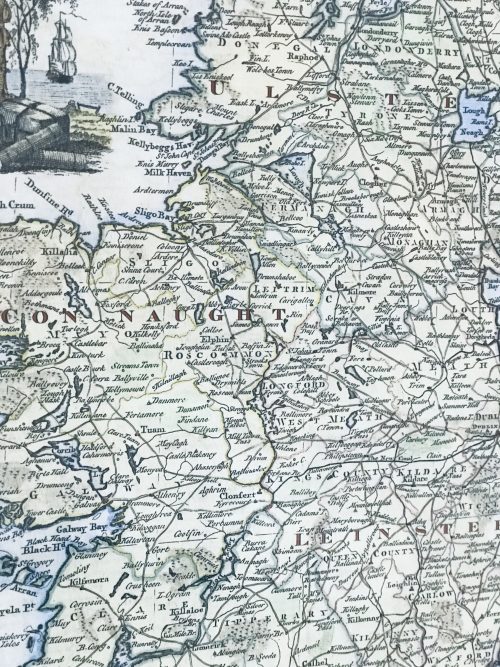-

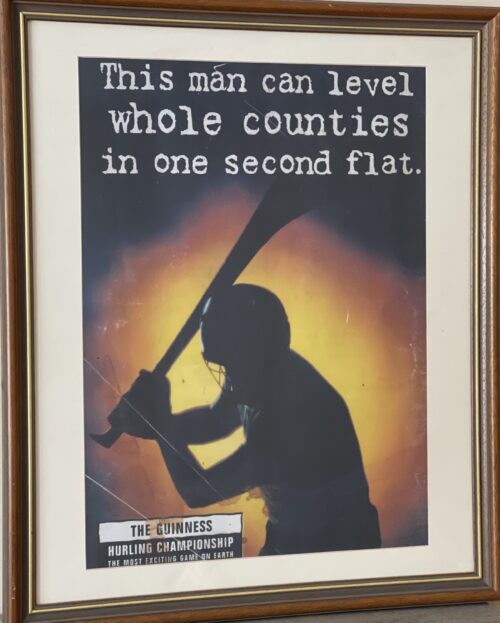 Its been hell for leather Guinness Hurling advert from the 90s. Dromkeen Co Limerick Dimensions : 65cm x55 cm " It was not until 1994 that the GAA decided that the football championship would benefit from bringing on a title sponsor in Bank of Ireland. Although an equivalent offer had been on the table for the hurling championship, Central Council pushed the plate away.Though the name of the potential sponsor wasn’t explicitly made public, everyone knew it was Guinness. More to the point, everyone knew why Central Council wouldn’t bite. As Mulvihill himself noted in his report to Congress, the offer was declined on the basis that “Central Council did not want an alcoholic drinks company associated with a major GAA competition”. As it turned out, Central Council had been deadlocked on the issue and it was the casting vote of then president Peter Quinn that put the kibosh on a deal with Guinness. Mulvihill’s disappointment was far from hidden, since he saw the wider damage caused by turning up the GAA nose at Guinness’s advances. “The unfortunate aspect of the situation,” he wrote, “is that hurling needs support on the promotion of the game much more than football.” Though it took the point of a bayonet to make them go for it, the GAA submitted in the end and on the day after the league final in 1995 , a three-year partnership with Guinness was announced. The deal would be worth £1 million a year, with half going to the sport and half going to the competition in the shape of marketing. That last bit was key. Guinness came up with a marketing campaign that fairly scorched across the general consciousness. Billboards screeched out slogans that feel almost corny at this remove but made a huge impact at the same time . This man can level whole counties in one second flat. This man can reach speeds of 100mph. This man can break hearts at 70 yards Its been Hell for Leather. Of course, all the marketing in the world can only do so much. Without a story to go alongside, the Guinness campaign might be forgotten now – or worse, remembered as an overblown blast of hot air dreamed up in some modish ad agency above in Dublin.Until the Clare hurlers came along and changed everything." Malachy Clerkin Irish Times GAA Correspondent Arthur Guinness started brewing ales in 1759 at the St James Gate Brewery,Dublin.On 31st December 1759 he signed a 9,000 year lease at £45 per annum for the unused brewery.Ten years later, on 19 May 1769, Guinness first exported his ale: he shipped six-and-a-half barrels to Great Britain before he started selling the dark beer porter in 1778. The first Guinness beers to use the term were Single Stout and Double Stout in the 1840s.Throughout the bulk of its history, Guinness produced only three variations of a single beer type: porter or single stout, double or extra and foreign stout for export. “Stout” originally referred to a beer’s strength, but eventually shifted meaning toward body and colour.Porter was also referred to as “plain”, as mentioned in the famous refrain of Flann O’Brien‘s poem “The Workman’s Friend”: “A pint of plain is your only man.” Already one of the top-three British and Irish brewers, Guinness’s sales soared from 350,000 barrels in 1868 to 779,000 barrels in 1876.In October 1886 Guinness became a public company, and was averaging sales of 1,138,000 barrels a year. This was despite the brewery’s refusal to either advertise or offer its beer at a discount. Even though Guinness owned no public houses, the company was valued at £6 million and shares were twenty times oversubscribed, with share prices rising to a 60 per cent premium on the first day of trading. The breweries pioneered several quality control efforts. The brewery hired the statistician William Sealy Gosset in 1899, who achieved lasting fame under the pseudonym “Student” for techniques developed for Guinness, particularly Student’s t-distribution and the even more commonly known Student’s t-test. By 1900 the brewery was operating unparalleled welfare schemes for its 5,000 employees. By 1907 the welfare schemes were costing the brewery £40,000 a year, which was one-fifth of the total wages bill. The improvements were suggested and supervised by Sir John Lumsden. By 1914, Guinness was producing 2,652,000 barrels of beer a year, which was more than double that of its nearest competitor Bass, and was supplying more than 10 per cent of the total UK beer market. In the 1930s, Guinness became the seventh largest company in the world. Before 1939, if a Guinness brewer wished to marry a Catholic, his resignation was requested. According to Thomas Molloy, writing in the Irish Independent, “It had no qualms about selling drink to Catholics but it did everything it could to avoid employing them until the 1960s.” Guinness thought they brewed their last porter in 1973. In the 1970s, following declining sales, the decision was taken to make Guinness Extra Stout more “drinkable”. The gravity was subsequently reduced, and the brand was relaunched in 1981. Pale malt was used for the first time, and isomerized hop extract began to be used. In 2014, two new porters were introduced: West Indies Porter and Dublin Porter. Guinness acquired the Distillers Company in 1986.This led to a scandal and criminal trialconcerning the artificial inflation of the Guinness share price during the takeover bid engineered by the chairman, Ernest Saunders. A subsequent £5.2 million success fee paid to an American lawyer and Guinness director, Tom Ward, was the subject of the case Guinness plc v Saunders, in which the House of Lords declared that the payment had been invalid. In the 1980s, as the IRA’s bombing campaign spread to London and the rest of Britain, Guinness considered scrapping the Harp as its logo. The company merged with Grand Metropolitan in 1997 to form Diageo. Due to controversy over the merger, the company was maintained as a separate entity within Diageo and has retained the rights to the product and all associated trademarks of Guinness.The Guinness brewery in Park Royal, London closed in 2005. The production of all Guinness sold in the UK and Ireland was moved to St. James’s Gate Brewery, Dublin. Guinness has also been referred to as “that black stuff”. Guinness had a fleet of ships, barges and yachts. The Irish Sunday Independent newspaper reported on 17 June 2007 that Diageo intended to close the historic St James’s Gate plant in Dublin and move to a greenfield site on the outskirts of the city.This news caused some controversy when it was announced.The following day, the Irish Daily Mail ran a follow-up story with a double page spread complete with images and a history of the plant since 1759. Initially, Diageo said that talk of a move was pure speculation but in the face of mounting speculation in the wake of the Sunday Independent article, the company confirmed that it is undertaking a “significant review of its operations”. This review was largely due to the efforts of the company’s ongoing drive to reduce the environmental impact of brewing at the St James’s Gate plant. On 23 November 2007, an article appeared in the Evening Herald, a Dublin newspaper, stating that the Dublin City Council, in the best interests of the city of Dublin, had put forward a motion to prevent planning permission ever being granted for development of the site, thus making it very difficult for Diageo to sell off the site for residential development. On 9 May 2008, Diageo announced that the St James’s Gate brewery will remain open and undergo renovations, but that breweries in Kilkenny and Dundalk will be closed by 2013 when a new larger brewery is opened near Dublin. The result will be a loss of roughly 250 jobs across the entire Diageo/Guinness workforce in Ireland.Two days later, the Sunday Independent again reported that Diageo chiefs had met with Tánaiste Mary Coughlan, the deputy leader of the Government of Ireland, about moving operations to Ireland from the UK to benefit from its lower corporation tax rates. Several UK firms have made the move in order to pay Ireland’s 12.5 per cent rate rather than the UK’s 28 per cent rate. Diageo released a statement to the London stock exchange denying the report.Despite the merger that created Diageo plc in 1997, Guinness has retained its right to the Guinness brand and associated trademarks and thus continues to trade under the traditional Guinness name despite trading under the corporation name Diageo for a brief period in 1997. In November 2015 it was announced that Guinness are planning to make their beer suitable for consumption by vegetarians and vegans by the end of 2016 through the introduction of a new filtration process at their existing Guinness Brewery that avoids the need to use isinglass from fish bladders to filter out yeast particles.This went into effect in 2017, per the company’s FAQ webpage where they state: “Our new filtration process has removed the use of isinglass as a means of filtration and vegans can now enjoy a pint of Guinness. All Guinness Draught in keg format is brewed without using isinglass. Full distribution of bottle and can formats will be in place by the end of 2017, so until then, our advice to vegans is to consume the product from the keg format only for now. Guinness stout is made from water, barley, roast malt extract, hops, and brewer’s yeast. A portion of the barley is roasted to give Guinness its dark colour and characteristic taste. It is pasteurisedand filtered. Until the late 1950s Guinness was still racked into wooden casks. In the late 1950s and early 1960s, Guinness ceased brewing cask-conditioned beers and developed a keg brewing system with aluminium kegs replacing the wooden casks; these were nicknamed “iron lungs”.Until 2016 the production of Guinness, as with many beers, involved the use of isinglass made from fish. Isinglass was used as a fining agent for settling out suspended matter in the vat. The isinglass was retained in the floor of the vat but it was possible that minute quantities might be carried over into the beer. Diageo announced in February 2018 that the use of isinglass in draught Guinness was to be discontinued and an alternative clarification agent would be used instead. This has made draught Guinness acceptable to vegans and vegetarians. Arguably its biggest change to date, in 1959 Guinness began using nitrogen, which changed the fundamental texture and flavour of the Guinness of the past as nitrogen bubbles are much smaller than CO2, giving a “creamier” and “smoother” consistency over a sharper and traditional CO2 taste. This step was taken after Michael Ash – a mathematician turned brewer – discovered the mechanism to make this possible. Nitrogen is less soluble than carbon dioxide, which allows the beer to be put under high pressure without making it fizzy. High pressure of the dissolved gas is required to enable very small bubbles to be formed by forcing the draught beer through fine holes in a plate in the tap, which causes the characteristic “surge” (the widget in cans and bottles achieves the same effect). This “widget” is a small plastic ball containing the nitrogen. The perceived smoothness of draught Guinness is due to its low level of carbon dioxide and the creaminess of the head caused by the very fine bubbles that arise from the use of nitrogen and the dispensing method described above. “Foreign Extra Stout” contains more carbon dioxide, causing a more acidic taste. Contemporary Guinness Draught and Extra Stout are weaker than they were in the 19th century, when they had an original gravity of over 1.070. Foreign Extra Stout and Special Export Stout, with abv of 7.5% and 9% respectively, are perhaps closest to the original in character.Although Guinness may appear to be black, it is officially a very dark shade of ruby. The most recent change in alcohol content from the Import Stout to the Extra Stout was due to a change in distribution through North American market. Consumer complaints have influenced recent distribution and bottle changes. Studies claim that Guinness can be beneficial to the heart. Researchers found that “‘antioxidantcompounds’ in the Guinness, similar to those found in certain fruits and vegetables, are responsible for the health benefits because they slow down the deposit of harmful cholesterol on the artery walls.”Guinness ran an advertising campaign in the 1920s which stemmed from market research – when people told the company that they felt good after their pint, the slogan, created by Dorothy L. Sayers–”Guinness is Good for You”. Advertising for alcoholic drinks that implies improved physical performance or enhanced personal qualities is now prohibited in Ireland.Diageo, the company that now manufactures Guinness, says: “We never make any medical claims for our drinks.” Origins : Dublin Dimensions : 43cm x 35cm
Its been hell for leather Guinness Hurling advert from the 90s. Dromkeen Co Limerick Dimensions : 65cm x55 cm " It was not until 1994 that the GAA decided that the football championship would benefit from bringing on a title sponsor in Bank of Ireland. Although an equivalent offer had been on the table for the hurling championship, Central Council pushed the plate away.Though the name of the potential sponsor wasn’t explicitly made public, everyone knew it was Guinness. More to the point, everyone knew why Central Council wouldn’t bite. As Mulvihill himself noted in his report to Congress, the offer was declined on the basis that “Central Council did not want an alcoholic drinks company associated with a major GAA competition”. As it turned out, Central Council had been deadlocked on the issue and it was the casting vote of then president Peter Quinn that put the kibosh on a deal with Guinness. Mulvihill’s disappointment was far from hidden, since he saw the wider damage caused by turning up the GAA nose at Guinness’s advances. “The unfortunate aspect of the situation,” he wrote, “is that hurling needs support on the promotion of the game much more than football.” Though it took the point of a bayonet to make them go for it, the GAA submitted in the end and on the day after the league final in 1995 , a three-year partnership with Guinness was announced. The deal would be worth £1 million a year, with half going to the sport and half going to the competition in the shape of marketing. That last bit was key. Guinness came up with a marketing campaign that fairly scorched across the general consciousness. Billboards screeched out slogans that feel almost corny at this remove but made a huge impact at the same time . This man can level whole counties in one second flat. This man can reach speeds of 100mph. This man can break hearts at 70 yards Its been Hell for Leather. Of course, all the marketing in the world can only do so much. Without a story to go alongside, the Guinness campaign might be forgotten now – or worse, remembered as an overblown blast of hot air dreamed up in some modish ad agency above in Dublin.Until the Clare hurlers came along and changed everything." Malachy Clerkin Irish Times GAA Correspondent Arthur Guinness started brewing ales in 1759 at the St James Gate Brewery,Dublin.On 31st December 1759 he signed a 9,000 year lease at £45 per annum for the unused brewery.Ten years later, on 19 May 1769, Guinness first exported his ale: he shipped six-and-a-half barrels to Great Britain before he started selling the dark beer porter in 1778. The first Guinness beers to use the term were Single Stout and Double Stout in the 1840s.Throughout the bulk of its history, Guinness produced only three variations of a single beer type: porter or single stout, double or extra and foreign stout for export. “Stout” originally referred to a beer’s strength, but eventually shifted meaning toward body and colour.Porter was also referred to as “plain”, as mentioned in the famous refrain of Flann O’Brien‘s poem “The Workman’s Friend”: “A pint of plain is your only man.” Already one of the top-three British and Irish brewers, Guinness’s sales soared from 350,000 barrels in 1868 to 779,000 barrels in 1876.In October 1886 Guinness became a public company, and was averaging sales of 1,138,000 barrels a year. This was despite the brewery’s refusal to either advertise or offer its beer at a discount. Even though Guinness owned no public houses, the company was valued at £6 million and shares were twenty times oversubscribed, with share prices rising to a 60 per cent premium on the first day of trading. The breweries pioneered several quality control efforts. The brewery hired the statistician William Sealy Gosset in 1899, who achieved lasting fame under the pseudonym “Student” for techniques developed for Guinness, particularly Student’s t-distribution and the even more commonly known Student’s t-test. By 1900 the brewery was operating unparalleled welfare schemes for its 5,000 employees. By 1907 the welfare schemes were costing the brewery £40,000 a year, which was one-fifth of the total wages bill. The improvements were suggested and supervised by Sir John Lumsden. By 1914, Guinness was producing 2,652,000 barrels of beer a year, which was more than double that of its nearest competitor Bass, and was supplying more than 10 per cent of the total UK beer market. In the 1930s, Guinness became the seventh largest company in the world. Before 1939, if a Guinness brewer wished to marry a Catholic, his resignation was requested. According to Thomas Molloy, writing in the Irish Independent, “It had no qualms about selling drink to Catholics but it did everything it could to avoid employing them until the 1960s.” Guinness thought they brewed their last porter in 1973. In the 1970s, following declining sales, the decision was taken to make Guinness Extra Stout more “drinkable”. The gravity was subsequently reduced, and the brand was relaunched in 1981. Pale malt was used for the first time, and isomerized hop extract began to be used. In 2014, two new porters were introduced: West Indies Porter and Dublin Porter. Guinness acquired the Distillers Company in 1986.This led to a scandal and criminal trialconcerning the artificial inflation of the Guinness share price during the takeover bid engineered by the chairman, Ernest Saunders. A subsequent £5.2 million success fee paid to an American lawyer and Guinness director, Tom Ward, was the subject of the case Guinness plc v Saunders, in which the House of Lords declared that the payment had been invalid. In the 1980s, as the IRA’s bombing campaign spread to London and the rest of Britain, Guinness considered scrapping the Harp as its logo. The company merged with Grand Metropolitan in 1997 to form Diageo. Due to controversy over the merger, the company was maintained as a separate entity within Diageo and has retained the rights to the product and all associated trademarks of Guinness.The Guinness brewery in Park Royal, London closed in 2005. The production of all Guinness sold in the UK and Ireland was moved to St. James’s Gate Brewery, Dublin. Guinness has also been referred to as “that black stuff”. Guinness had a fleet of ships, barges and yachts. The Irish Sunday Independent newspaper reported on 17 June 2007 that Diageo intended to close the historic St James’s Gate plant in Dublin and move to a greenfield site on the outskirts of the city.This news caused some controversy when it was announced.The following day, the Irish Daily Mail ran a follow-up story with a double page spread complete with images and a history of the plant since 1759. Initially, Diageo said that talk of a move was pure speculation but in the face of mounting speculation in the wake of the Sunday Independent article, the company confirmed that it is undertaking a “significant review of its operations”. This review was largely due to the efforts of the company’s ongoing drive to reduce the environmental impact of brewing at the St James’s Gate plant. On 23 November 2007, an article appeared in the Evening Herald, a Dublin newspaper, stating that the Dublin City Council, in the best interests of the city of Dublin, had put forward a motion to prevent planning permission ever being granted for development of the site, thus making it very difficult for Diageo to sell off the site for residential development. On 9 May 2008, Diageo announced that the St James’s Gate brewery will remain open and undergo renovations, but that breweries in Kilkenny and Dundalk will be closed by 2013 when a new larger brewery is opened near Dublin. The result will be a loss of roughly 250 jobs across the entire Diageo/Guinness workforce in Ireland.Two days later, the Sunday Independent again reported that Diageo chiefs had met with Tánaiste Mary Coughlan, the deputy leader of the Government of Ireland, about moving operations to Ireland from the UK to benefit from its lower corporation tax rates. Several UK firms have made the move in order to pay Ireland’s 12.5 per cent rate rather than the UK’s 28 per cent rate. Diageo released a statement to the London stock exchange denying the report.Despite the merger that created Diageo plc in 1997, Guinness has retained its right to the Guinness brand and associated trademarks and thus continues to trade under the traditional Guinness name despite trading under the corporation name Diageo for a brief period in 1997. In November 2015 it was announced that Guinness are planning to make their beer suitable for consumption by vegetarians and vegans by the end of 2016 through the introduction of a new filtration process at their existing Guinness Brewery that avoids the need to use isinglass from fish bladders to filter out yeast particles.This went into effect in 2017, per the company’s FAQ webpage where they state: “Our new filtration process has removed the use of isinglass as a means of filtration and vegans can now enjoy a pint of Guinness. All Guinness Draught in keg format is brewed without using isinglass. Full distribution of bottle and can formats will be in place by the end of 2017, so until then, our advice to vegans is to consume the product from the keg format only for now. Guinness stout is made from water, barley, roast malt extract, hops, and brewer’s yeast. A portion of the barley is roasted to give Guinness its dark colour and characteristic taste. It is pasteurisedand filtered. Until the late 1950s Guinness was still racked into wooden casks. In the late 1950s and early 1960s, Guinness ceased brewing cask-conditioned beers and developed a keg brewing system with aluminium kegs replacing the wooden casks; these were nicknamed “iron lungs”.Until 2016 the production of Guinness, as with many beers, involved the use of isinglass made from fish. Isinglass was used as a fining agent for settling out suspended matter in the vat. The isinglass was retained in the floor of the vat but it was possible that minute quantities might be carried over into the beer. Diageo announced in February 2018 that the use of isinglass in draught Guinness was to be discontinued and an alternative clarification agent would be used instead. This has made draught Guinness acceptable to vegans and vegetarians. Arguably its biggest change to date, in 1959 Guinness began using nitrogen, which changed the fundamental texture and flavour of the Guinness of the past as nitrogen bubbles are much smaller than CO2, giving a “creamier” and “smoother” consistency over a sharper and traditional CO2 taste. This step was taken after Michael Ash – a mathematician turned brewer – discovered the mechanism to make this possible. Nitrogen is less soluble than carbon dioxide, which allows the beer to be put under high pressure without making it fizzy. High pressure of the dissolved gas is required to enable very small bubbles to be formed by forcing the draught beer through fine holes in a plate in the tap, which causes the characteristic “surge” (the widget in cans and bottles achieves the same effect). This “widget” is a small plastic ball containing the nitrogen. The perceived smoothness of draught Guinness is due to its low level of carbon dioxide and the creaminess of the head caused by the very fine bubbles that arise from the use of nitrogen and the dispensing method described above. “Foreign Extra Stout” contains more carbon dioxide, causing a more acidic taste. Contemporary Guinness Draught and Extra Stout are weaker than they were in the 19th century, when they had an original gravity of over 1.070. Foreign Extra Stout and Special Export Stout, with abv of 7.5% and 9% respectively, are perhaps closest to the original in character.Although Guinness may appear to be black, it is officially a very dark shade of ruby. The most recent change in alcohol content from the Import Stout to the Extra Stout was due to a change in distribution through North American market. Consumer complaints have influenced recent distribution and bottle changes. Studies claim that Guinness can be beneficial to the heart. Researchers found that “‘antioxidantcompounds’ in the Guinness, similar to those found in certain fruits and vegetables, are responsible for the health benefits because they slow down the deposit of harmful cholesterol on the artery walls.”Guinness ran an advertising campaign in the 1920s which stemmed from market research – when people told the company that they felt good after their pint, the slogan, created by Dorothy L. Sayers–”Guinness is Good for You”. Advertising for alcoholic drinks that implies improved physical performance or enhanced personal qualities is now prohibited in Ireland.Diageo, the company that now manufactures Guinness, says: “We never make any medical claims for our drinks.” Origins : Dublin Dimensions : 43cm x 35cm -
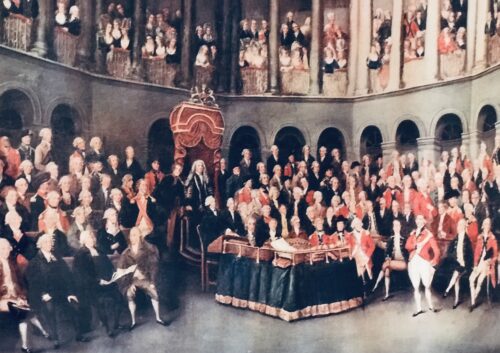
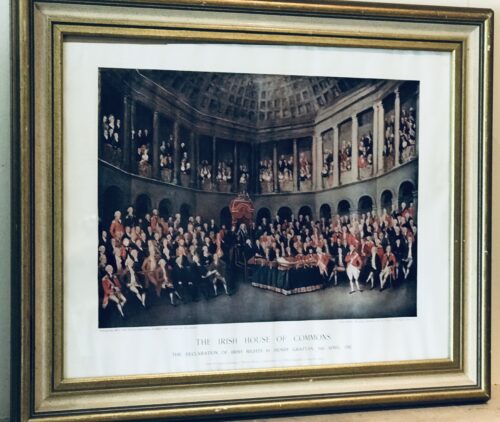 50cm x 60cm Dublin This rare and historical print depicts Grattans Irish House of Parliament before it fell under the Act of Union in 1800,whereupon Ireland would be governed from London for the next 120 years.This parliament was loyal to the King and was essentially an assembly of the leading members of the landed gentry of the country,loyal to the Anglican Church of Ireland who owned most of the land.The politicians of the national party now fought for the Irish parliament, not with the intention of liberating the Catholic majority, but to set the Irish parliament free from constitutional bondage to the British Privy Council. By virtue of Poynings' Law, a statute of King Henry VII of England, all proposed Irish legislation had to be submitted to the Privy Council for its approval under the Great Seal of England before being passed by the Irish parliament. A bill so approved might be accepted or rejected, but not amended. More recent British Acts had further emphasised the complete dependence of the Irish parliament, and the appellate jurisdiction of the Irish House of Lords had also been annulled. Moreover, the British Houses claimed and exercised the power to legislate directly for Ireland without even the nominal concurrence of the parliament in Dublin. This was the constitution which William Molyneux and Swift had denounced, which Flood had attacked, and which Grattan was to destroy, becoming leaders of the Patriot movement.Calls for the legislative independence of Ireland at the Irish Volunteer Convention at Dungannon greatly influenced the decision of the government in 1782 to make concessions. It was through ranks of Volunteers drawn up outside the parliament house in Dublin that Grattan passed on 16 April 1782, amidst unparalleled popular enthusiasm, to move a declaration of the independence of the Irish parliament. "I found Ireland on her knees," Grattan exclaimed, "I watched over her with a paternal solicitude; I have traced her progress from injuries to arms, and from arms to liberty. Spirit of Swift, spirit of Molyneux, your genius has prevailed! Ireland is now a nation!" After a month of negotiation the claims of Ireland were conceded. The gratitude of his countrymen to Grattan was shown by a parliamentary grant of £100,000, which had to be reduced by half before he would accept it.Grattan then asked for the British House of Commons to reconfirm the London government's decision, and on 22 January 1783 the final Act was passed by parliament in London.However by 1800 under the Act of Union Grattans Parliament would cease to exist. From the perspective of Great Britain, the union was desirable because of the uncertainty that followed the Irish Rebellion of 1798 and the French Revolution of 1789; if Ireland adopted Catholic Emancipation, willingly or not, a Roman Catholic parliament could break away from Britain and ally with the French, while the same measure within a united kingdom would exclude that possibility. Also the Irish and British parliaments, when creating a regency during King George III's "madness", gave the Prince Regent different powers. These considerations led Great Britain to decide to attempt merger of the two kingdoms and their parliaments.The final passage of the Act in the Irish Parliament was achieved with substantial majorities, in part according to contemporary documents through bribery, namely the awarding of peerages and honours to critics to get their votes.Whereas the first attempt had been defeated in the Irish House of Commons by 109 votes against to 104 for, the second vote in 1800 produced a result of 158 to 115. Yet in the heart of every Irishman,whatever his politics or religion ,there is a tender spot for Grattans Parliament and the genius, wit and oratory of its members will live long and be cherished with pride by their countrymen.The present Bank of Ireland at College Green,directly adjacent to Trinity College Dublin,was the site of the old Parliament building ,built in1729 and the worlds first purpose built bi-cameral Parliament House .Architects were Pearce and James Gandon .
50cm x 60cm Dublin This rare and historical print depicts Grattans Irish House of Parliament before it fell under the Act of Union in 1800,whereupon Ireland would be governed from London for the next 120 years.This parliament was loyal to the King and was essentially an assembly of the leading members of the landed gentry of the country,loyal to the Anglican Church of Ireland who owned most of the land.The politicians of the national party now fought for the Irish parliament, not with the intention of liberating the Catholic majority, but to set the Irish parliament free from constitutional bondage to the British Privy Council. By virtue of Poynings' Law, a statute of King Henry VII of England, all proposed Irish legislation had to be submitted to the Privy Council for its approval under the Great Seal of England before being passed by the Irish parliament. A bill so approved might be accepted or rejected, but not amended. More recent British Acts had further emphasised the complete dependence of the Irish parliament, and the appellate jurisdiction of the Irish House of Lords had also been annulled. Moreover, the British Houses claimed and exercised the power to legislate directly for Ireland without even the nominal concurrence of the parliament in Dublin. This was the constitution which William Molyneux and Swift had denounced, which Flood had attacked, and which Grattan was to destroy, becoming leaders of the Patriot movement.Calls for the legislative independence of Ireland at the Irish Volunteer Convention at Dungannon greatly influenced the decision of the government in 1782 to make concessions. It was through ranks of Volunteers drawn up outside the parliament house in Dublin that Grattan passed on 16 April 1782, amidst unparalleled popular enthusiasm, to move a declaration of the independence of the Irish parliament. "I found Ireland on her knees," Grattan exclaimed, "I watched over her with a paternal solicitude; I have traced her progress from injuries to arms, and from arms to liberty. Spirit of Swift, spirit of Molyneux, your genius has prevailed! Ireland is now a nation!" After a month of negotiation the claims of Ireland were conceded. The gratitude of his countrymen to Grattan was shown by a parliamentary grant of £100,000, which had to be reduced by half before he would accept it.Grattan then asked for the British House of Commons to reconfirm the London government's decision, and on 22 January 1783 the final Act was passed by parliament in London.However by 1800 under the Act of Union Grattans Parliament would cease to exist. From the perspective of Great Britain, the union was desirable because of the uncertainty that followed the Irish Rebellion of 1798 and the French Revolution of 1789; if Ireland adopted Catholic Emancipation, willingly or not, a Roman Catholic parliament could break away from Britain and ally with the French, while the same measure within a united kingdom would exclude that possibility. Also the Irish and British parliaments, when creating a regency during King George III's "madness", gave the Prince Regent different powers. These considerations led Great Britain to decide to attempt merger of the two kingdoms and their parliaments.The final passage of the Act in the Irish Parliament was achieved with substantial majorities, in part according to contemporary documents through bribery, namely the awarding of peerages and honours to critics to get their votes.Whereas the first attempt had been defeated in the Irish House of Commons by 109 votes against to 104 for, the second vote in 1800 produced a result of 158 to 115. Yet in the heart of every Irishman,whatever his politics or religion ,there is a tender spot for Grattans Parliament and the genius, wit and oratory of its members will live long and be cherished with pride by their countrymen.The present Bank of Ireland at College Green,directly adjacent to Trinity College Dublin,was the site of the old Parliament building ,built in1729 and the worlds first purpose built bi-cameral Parliament House .Architects were Pearce and James Gandon . The Irish House of Commons by Francis Wheatley (1780) shows Grattan (standing on right in red jacket) addressing the House.
The Irish House of Commons by Francis Wheatley (1780) shows Grattan (standing on right in red jacket) addressing the House. -
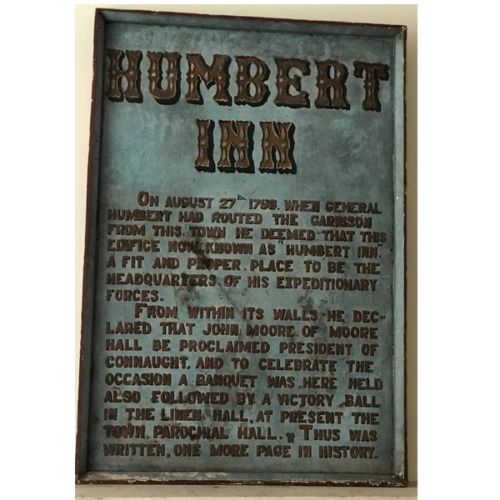 Extremely unusual & culturally significant historical sign from a once famous pub in Castlebar Co Mayo, the historic and now sadly closed down Humbert Inn.Please email us directly to enquire about this most unusual item at irishpubemporium@gmail.com. "Located on the Main Street of Castlebar, The Humbert Inn excelled in its hospitality to the public for over 200 years. Its name was derived from the fact that the French General Jean Humbert with his second in command General Sarrazin located their headquarters within the building during the United Irishmen rebellion of 1798. Originally until 1912 due to rates purposes, the premises also consisted of what is known today as Paddy Fahey’s shop and over the years has been used as hotel, restaurant and public house. In 1798 the site of Paddy Fahey’s and the Humbert Inn was known as Geevy’s Hotel. A banquet was held there after the 1798 Rising and it was in The Humbert Inn premises, that John Moore was declared first President of Connaught! The public bar was unique in appearance with its interior rough cut stone walls, arches, Liscannor stone floor and a façade that has changed little over the past fifty years.
Extremely unusual & culturally significant historical sign from a once famous pub in Castlebar Co Mayo, the historic and now sadly closed down Humbert Inn.Please email us directly to enquire about this most unusual item at irishpubemporium@gmail.com. "Located on the Main Street of Castlebar, The Humbert Inn excelled in its hospitality to the public for over 200 years. Its name was derived from the fact that the French General Jean Humbert with his second in command General Sarrazin located their headquarters within the building during the United Irishmen rebellion of 1798. Originally until 1912 due to rates purposes, the premises also consisted of what is known today as Paddy Fahey’s shop and over the years has been used as hotel, restaurant and public house. In 1798 the site of Paddy Fahey’s and the Humbert Inn was known as Geevy’s Hotel. A banquet was held there after the 1798 Rising and it was in The Humbert Inn premises, that John Moore was declared first President of Connaught! The public bar was unique in appearance with its interior rough cut stone walls, arches, Liscannor stone floor and a façade that has changed little over the past fifty years.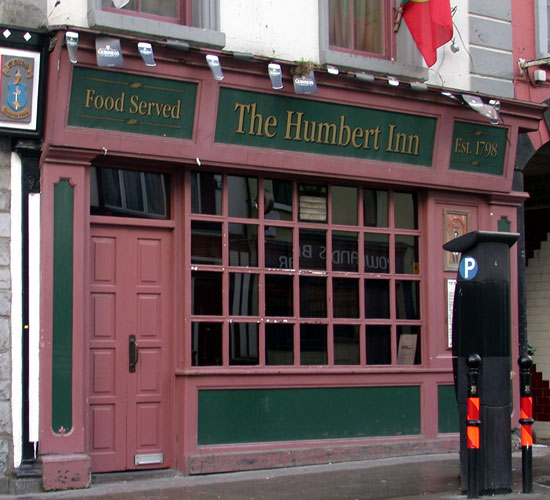
The premises has changed hands many times over the years, more recent owners including Tom Coucil, the Moran family and since 1994 John Connaughton, more popularly known as 'John Humbert'. While memories aplenty abound about The Humbert Inn with many instances of people today stating that they are the third generation of their family to call into The Humbert. Its lasting legacy will be an outstanding and legendary venue for all that is musical. The Humbert Inn was long associated with encouraging local musicians and providing the public with a steady stream of talent. Everything from traditional sessions to Industrial Rock has been catered for, everything from one guitar, 6 piece bands to many DJs have enthralled weekly audiences! In many cases their audience trying for a pint, while singing and dancing at the same time. Always a multi-talented bunch, The Humbert regulars! The most historically famous of these bands will be 'General Humbert' consisting of Steve Dunford (bodhran, bones), John Donegan (mandolin, harmonium), Ruairi Somers (uileann pipes, tin whistles, bagpipes), Shay Kavanagh (guitar, bouzouki) and one Miss Mary Black (vocals, bodhran) from approx 1972 until 1982. Mary Black’s brother Mick was working with the then P&T in Castlebar, he along with his brother Shay informed a group of Humbert musicians including, John Hoban and Frank O’Reilly, that he 'had a sister that could sing a bit (brotherly understatement) and would they be interested if she sang with them'. Mary Black may have received her first taste of success with 'General Humbert' in the ‘70s and recorded her first album in 1982. But, along with playing venues in Dublin, she started out singing in Castlebar with traditional group 'La Salle' which included John Dunford and Fintan Murphy within The Humbert a good ten years before her international success. Christmas in particular was always memorable in The Humbert, it was a major home coming venue and meeting place. If you were brought up in Castlebar, were of a certain age, then chances were there was one of two places you would have been found on Christmas Eve, The Humbert or Rays!. The Humbert Inn can also boast its very own VIP list among its regulars with two crowned Roses of Tralee Mindy O’Sullivan and Aoibhinn Ni Shulleabhain along with Fair City actress Vicky Burke. Plus any number of quality customers, musicians, fine sportsmen and women, business people and the odd politician. Fate had decided a different path for The Humbert and further to this an offer to buy the premises by a local developer was accepted. This has resulted in the developer’s decision to convert the building into retail outlets and apartments, thereby no longer retaining the premises two hundred year reign in the hospitality trade.Public opinion has stated a desire to at least retain the look of the existing bar, possibly using same as a restaurant, wine bar, part of the Linenhall for exhibitions or even as a Tourist Office However, the general consensus is an overall request that The Humbert Inn remains a public bar while recognising the logic in upper floor apartment conversion. The future of The Humbert has been proposed by the developer, but it is the present planning section of the Town Council who will ultimately decide this historic buildings fate as rumours abound of its possible demolition! What ever the future holds for The Humbert Inn, its last weekend under the command of General John Connaughton will be a musical filled celebration which John has requested to end quietly on its last closing time on Sunday 3rd September. Which is curiously the same date that Humbert and his men left The Humbert Inn premises in 1798! It will be an emotional time for both punters, staff and owner, an end of an era no matter what the future holds, so it is important that it is understood that the bar will be closing promptly on the last night" Origins : Co Mayo Dimensions : 88cm x60.5cm 5kg -
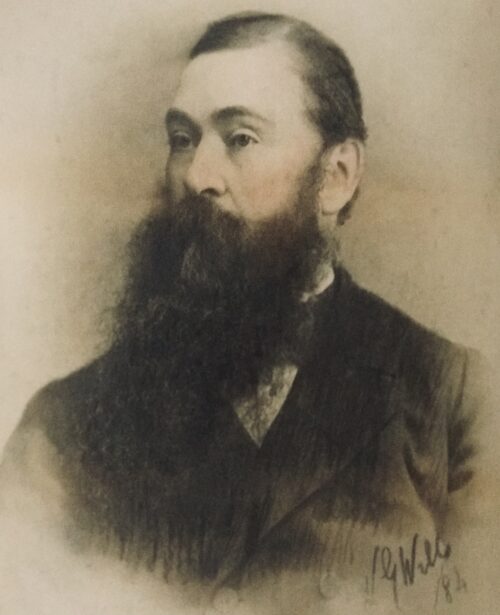
 85cm x 72cm Rathdrum Co Wicklow Charles Stewart Parnell (1846-1891) will be remembered as one of the most iconic and indeed controversial politicians in Irish history.MP and Leader of the Irish Parliamentary or Home Rule Party from1882 to 1891 until revelations of his adulterous love affair with Kitty O'Shea forced his resignation.He died shortly afterwards from pneumonia in the arms of his newly divorced and remarried wife Katherine.His death was considered to be a direct result of the stresses he endured because of the Victorian era scandal and his subsequent funeral at Glasnevin Cemetery in Dublin was attended by more than 200000 people.His notability was such that his gravestone of unhewn Wicklow granite, erected in 1940,reads only Parnell. This faithful portrayal of Parnell,well over 130 years old, by the artist JG Wills dates to 1884 and is a beautiful homage to the "uncrowned king of Ireland".
85cm x 72cm Rathdrum Co Wicklow Charles Stewart Parnell (1846-1891) will be remembered as one of the most iconic and indeed controversial politicians in Irish history.MP and Leader of the Irish Parliamentary or Home Rule Party from1882 to 1891 until revelations of his adulterous love affair with Kitty O'Shea forced his resignation.He died shortly afterwards from pneumonia in the arms of his newly divorced and remarried wife Katherine.His death was considered to be a direct result of the stresses he endured because of the Victorian era scandal and his subsequent funeral at Glasnevin Cemetery in Dublin was attended by more than 200000 people.His notability was such that his gravestone of unhewn Wicklow granite, erected in 1940,reads only Parnell. This faithful portrayal of Parnell,well over 130 years old, by the artist JG Wills dates to 1884 and is a beautiful homage to the "uncrowned king of Ireland". -
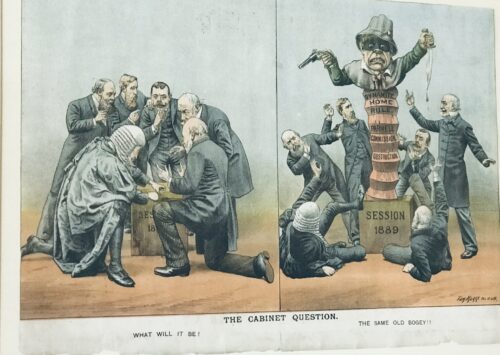
 Original,multi faceted,interesting historical caricature by the artist Tom Merry,surrounding the complex Home Rule Question which dominated political discourse both in Ireland and in London for much of the late 19th Century and early 20th Century,right up to the outbreak of WW1.This supplement came with the United Irishman publication and is a fascinating insight into the politics of the period, in particular emphasising Parnells obstructionist tactics in Westminster. Abbeyleix Co Laois 54cm x 74cm hat was Home Rule? Home Rule was the demand that the governance of Ireland be returned from Westminster to a domestic parliament in Ireland. Ireland had had its own parliament up to 1800 when the Act of Union ended Irish representation at the parliament sitting at College Green in Dublin. Under the Union, MPs elected for Irish constituencies went over to Westminster and sat alongside English, Scottish, and Welsh MPs in a legislature that had jurisdiction over the whole of both islands as well as the colonies of the British Empire. When was the Home Rule movement established? The idea of Home Rule dates from 1870 but it should be viewed as part of a longer tradition which aimed at revising the Anglo-Irish relationship by constitutional methods. The first attempt to repeal the Act of Union was made by Daniel O’Connell in the 1840s. This was ultimately a failure and Irish politics in the mid-nineteenth century was dominated by MPs acting as Irish representatives of the Liberal and Tory parties. In 1870, Isaac Butt, a barrister and former Tory MP, founded the Irish Home Government Association. The movement combined a powerful cross section of progressive landowners, tenant rights activists, and supporters and sympathisers of the failed Fenian uprising of 1867 to create a third way in Irish politics. By 1874, styled as the Home Rule League, Butt’s nascent party succeeded in gaining the loose allegiance of 59 out of 103 Irish MPs. What about Parnell? The most significant event to occur in the emergence of a more powerful Home Rule movement was in 1880 when Charles Stewart Parnell was elected chairman of the party. Parnell was a master organiser. He ran the party like a machine from parish level to parliament and by coupling the demand for Home Rule with the intensifying agitation for tenant rights in Ireland, Home Rule became an extremely powerful force in politics. Between the land question and the demand for Home Rule, Irish issues consumed a large proportion of parliamentary time at Westminster during the 1880s and intermittently thereafter. Did the Home Rule movement achieve anything? On three occasions, a Home Rule bill was introduced to the House of Commons. In 1886, Prime Minister William E. Gladstone introduced the first Home Rule bill. However, this move split his governing Liberal Party and the bill was defeated in the House of Commons. In 1893, a second Home Rule bill managed to pass through the House of Commons but it was thrown out by the House of Lords. Once more, in 1912, a Home Rule bill passed the House of Commons. The powers of the House of Lords had been curtailed in 1911 and, under the new parliamentary mechanisms, the Lords could only delay rather than reject the bill. At the beginning of 1913, the Liberal Lord Crewe, former Lord Lieutenant of Ireland, opened the debates on the bill in the Lords. The rejection of Home Rule by the Lords was a fait accompli but, with only the power of delay remaining to them, the real danger to the passage of the bill came from outside of Parliament, where Unionist Ulster was organising in earnest its resistance to the imposition of the bill on the North East. Why did British governments agree to introduce Home Rule bills to parliament? On all three of the occasions when Home Rule bills were introduced to the House of Commons, Home Rulers held the balance of power between the Liberal and Conservative parties which were roughly evenly split. Finding themselves in this position, Home Rulers were able to negotiate for the introduction of a Home Rule bill in exchange for supporting the Liberal Party, traditionally a sympathetic ally on the Irish question. This support gave the Liberals the required majority to form a government. The exact same situation exists in Westminster today where Nick Clegg’s Liberal Democrats hold the balance between the Labour and Conservative parties, and David Cameron’s government requires the support of the Liberal Democrats to stay in power. How does Home Rule fit into the wider British context? Home Rule was an extremely important concept in the British Empire in the late nineteenth and early twentieth centuries. To fully appreciate its significance, it must be viewed in an imperial rather than a purely Irish concept. Before the outbreak of the First World War, the nature of government in the British Empire was changing. Greater independence and forms of domestic governance were granted to Canada, Australia, and South Africa in 1867, 1900, and 1909 respectively. Thus, Britain can be seen to have been gradually liberalising its system of imperial governance, at least for ‘civilised’ components of the empire. This contrasts starkly with the disorderly and chaotic nature of de-colonisation that was experienced by Britain, France, and other European powers following the Second World War.
Original,multi faceted,interesting historical caricature by the artist Tom Merry,surrounding the complex Home Rule Question which dominated political discourse both in Ireland and in London for much of the late 19th Century and early 20th Century,right up to the outbreak of WW1.This supplement came with the United Irishman publication and is a fascinating insight into the politics of the period, in particular emphasising Parnells obstructionist tactics in Westminster. Abbeyleix Co Laois 54cm x 74cm hat was Home Rule? Home Rule was the demand that the governance of Ireland be returned from Westminster to a domestic parliament in Ireland. Ireland had had its own parliament up to 1800 when the Act of Union ended Irish representation at the parliament sitting at College Green in Dublin. Under the Union, MPs elected for Irish constituencies went over to Westminster and sat alongside English, Scottish, and Welsh MPs in a legislature that had jurisdiction over the whole of both islands as well as the colonies of the British Empire. When was the Home Rule movement established? The idea of Home Rule dates from 1870 but it should be viewed as part of a longer tradition which aimed at revising the Anglo-Irish relationship by constitutional methods. The first attempt to repeal the Act of Union was made by Daniel O’Connell in the 1840s. This was ultimately a failure and Irish politics in the mid-nineteenth century was dominated by MPs acting as Irish representatives of the Liberal and Tory parties. In 1870, Isaac Butt, a barrister and former Tory MP, founded the Irish Home Government Association. The movement combined a powerful cross section of progressive landowners, tenant rights activists, and supporters and sympathisers of the failed Fenian uprising of 1867 to create a third way in Irish politics. By 1874, styled as the Home Rule League, Butt’s nascent party succeeded in gaining the loose allegiance of 59 out of 103 Irish MPs. What about Parnell? The most significant event to occur in the emergence of a more powerful Home Rule movement was in 1880 when Charles Stewart Parnell was elected chairman of the party. Parnell was a master organiser. He ran the party like a machine from parish level to parliament and by coupling the demand for Home Rule with the intensifying agitation for tenant rights in Ireland, Home Rule became an extremely powerful force in politics. Between the land question and the demand for Home Rule, Irish issues consumed a large proportion of parliamentary time at Westminster during the 1880s and intermittently thereafter. Did the Home Rule movement achieve anything? On three occasions, a Home Rule bill was introduced to the House of Commons. In 1886, Prime Minister William E. Gladstone introduced the first Home Rule bill. However, this move split his governing Liberal Party and the bill was defeated in the House of Commons. In 1893, a second Home Rule bill managed to pass through the House of Commons but it was thrown out by the House of Lords. Once more, in 1912, a Home Rule bill passed the House of Commons. The powers of the House of Lords had been curtailed in 1911 and, under the new parliamentary mechanisms, the Lords could only delay rather than reject the bill. At the beginning of 1913, the Liberal Lord Crewe, former Lord Lieutenant of Ireland, opened the debates on the bill in the Lords. The rejection of Home Rule by the Lords was a fait accompli but, with only the power of delay remaining to them, the real danger to the passage of the bill came from outside of Parliament, where Unionist Ulster was organising in earnest its resistance to the imposition of the bill on the North East. Why did British governments agree to introduce Home Rule bills to parliament? On all three of the occasions when Home Rule bills were introduced to the House of Commons, Home Rulers held the balance of power between the Liberal and Conservative parties which were roughly evenly split. Finding themselves in this position, Home Rulers were able to negotiate for the introduction of a Home Rule bill in exchange for supporting the Liberal Party, traditionally a sympathetic ally on the Irish question. This support gave the Liberals the required majority to form a government. The exact same situation exists in Westminster today where Nick Clegg’s Liberal Democrats hold the balance between the Labour and Conservative parties, and David Cameron’s government requires the support of the Liberal Democrats to stay in power. How does Home Rule fit into the wider British context? Home Rule was an extremely important concept in the British Empire in the late nineteenth and early twentieth centuries. To fully appreciate its significance, it must be viewed in an imperial rather than a purely Irish concept. Before the outbreak of the First World War, the nature of government in the British Empire was changing. Greater independence and forms of domestic governance were granted to Canada, Australia, and South Africa in 1867, 1900, and 1909 respectively. Thus, Britain can be seen to have been gradually liberalising its system of imperial governance, at least for ‘civilised’ components of the empire. This contrasts starkly with the disorderly and chaotic nature of de-colonisation that was experienced by Britain, France, and other European powers following the Second World War. -
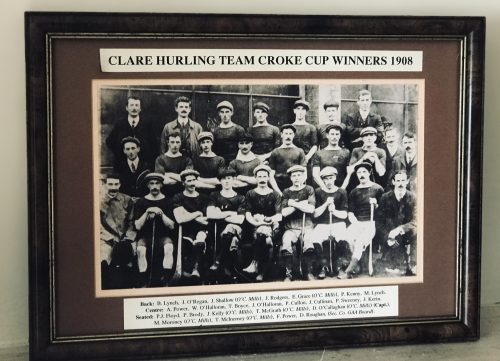 Superb print of the 1908 Clare Hurling Team who won the Croke Cup. Origins : Ennistymon Co Clare Dimensions: 33cm x 40cm. Glazed
Superb print of the 1908 Clare Hurling Team who won the Croke Cup. Origins : Ennistymon Co Clare Dimensions: 33cm x 40cm. Glazed
Dimensions ; 30cm x 40cmDr Croke Cup Medal, 1908 The Dr Croke Cup was a second inter-county competition instituted in both hurling and football in 1896. Clare was the first winner of the Dr Croke Cup for Hurling in 1896. This medal was won by Ned Grace, one of seven O’Callaghan’s Mills players on the Croke Cup winning Hurling team of 1908. -
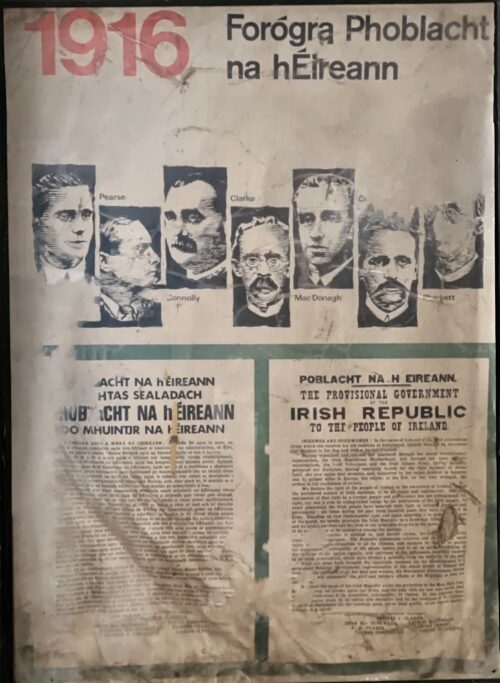
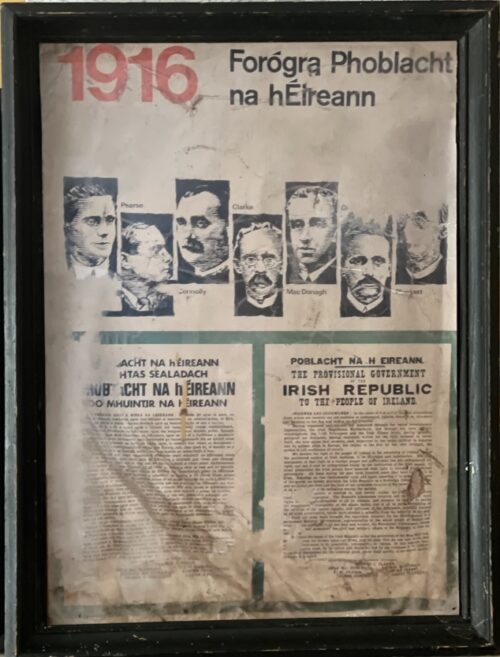 This hard to find 1916 proclamation of Independence as signed by the 12 is an authentic example of the ones that used to hang in every national or primary school in Ireland and would date to the 1950s.There is some age related wear to one side of the board but it still will make an outstanding display piece due to its obvious authenticity and recognisability. Cloverfield Co Limerick 80cm x 60cm The Proclamation of the Republic (Irish: Forógra na Poblachta), also known as the 1916 Proclamation or the Easter Proclamation, was a document issued by the Irish Volunteers and the Irish Citizen Army during the Easter Rising in Ireland, which began on 24 April 1916. In it, the Military Council of the Irish Republican Brotherhood, styling itself the "Provisional Government of the Irish Republic", proclaimed Ireland's independence from the United Kingdom. The reading of the proclamation by Patrick Pearse outside the General Post Office (GPO) on Sackville Street (now called O'Connell Street), Dublin's main thoroughfare, marked the beginning of the Rising. The proclamation was modelled on a similar independence proclamation issued during the 1803 rebellion by Robert Emmet.Though the Rising failed in military terms, the principles of the Proclamation to varying degrees influenced the thinking of later generations of Irish politicians. The document consisted of a number of assertions:
This hard to find 1916 proclamation of Independence as signed by the 12 is an authentic example of the ones that used to hang in every national or primary school in Ireland and would date to the 1950s.There is some age related wear to one side of the board but it still will make an outstanding display piece due to its obvious authenticity and recognisability. Cloverfield Co Limerick 80cm x 60cm The Proclamation of the Republic (Irish: Forógra na Poblachta), also known as the 1916 Proclamation or the Easter Proclamation, was a document issued by the Irish Volunteers and the Irish Citizen Army during the Easter Rising in Ireland, which began on 24 April 1916. In it, the Military Council of the Irish Republican Brotherhood, styling itself the "Provisional Government of the Irish Republic", proclaimed Ireland's independence from the United Kingdom. The reading of the proclamation by Patrick Pearse outside the General Post Office (GPO) on Sackville Street (now called O'Connell Street), Dublin's main thoroughfare, marked the beginning of the Rising. The proclamation was modelled on a similar independence proclamation issued during the 1803 rebellion by Robert Emmet.Though the Rising failed in military terms, the principles of the Proclamation to varying degrees influenced the thinking of later generations of Irish politicians. The document consisted of a number of assertions:- that the Rising's leaders spoke for Ireland (a claim historically made by Irish insurrectionary movements);
- that the Rising marked another wave of attempts to achieve independence through force of arms;
- that the Irish Republican Brotherhood, the Irish Volunteers and the Irish Citizen Army were central to the Rising;
- "the right of the people of Ireland to the ownership of Ireland"
- that the form of government was to be a republic;
- a guarantee of "religious and civil liberty, equal rights and equal opportunities to all its citizens", the first mention of gender equality, given that Irish women under British law were not allowed to vote;
- a commitment to universal suffrage, a phenomenon limited at the time to only a handful of countries, not including the UK;
- a promise of "cherishing all the children of the nation equally". Although these words have been quoted since the 1990s by children's rights advocates, "children of the nation" refers to all Irish people;
- disputes between nationalists and unionists are attributed to "differences carefully fostered by an alien government", a rejection of what was later dubbed two-nations theory.
- Thomas J. Clarke
- Seán Mac Diarmada
- Thomas MacDonagh
- P. H. Pearse
- Éamonn Ceannt
- James Connolly
- Joseph Plunkett
- Signed on behalf of the Provisional Government:
-
-
-
- THOMAS J. CLARKE
-
-
-
- SEAN Mac DIARMADA
- P. H. PEARSE
- JAMES CONNOLLY
- THOMAS MacDONAGH
- EAMONN CEANNT
- JOSEPH PLUNKETT
-

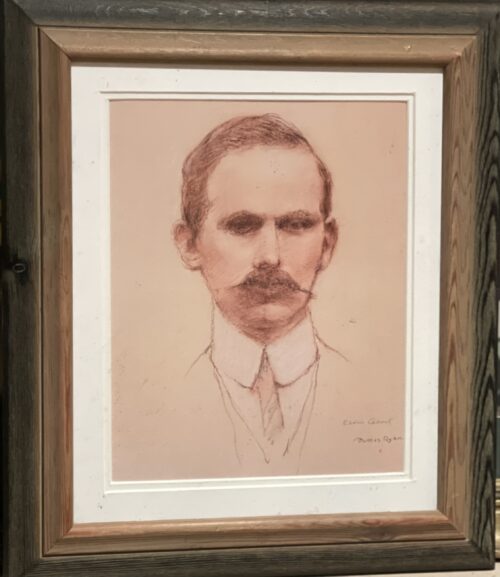 38cm x 33cm Dublin Eamonn Ceannt (21 September 1881 – 8 May 1916), born Edward Thomas Kent, was an Irish republican, mostly known for his role in the Easter Rising of 1916. The Easter Rising (Irish: Éirí Amach na Cásca), also known as the Easter Rebellion, was an armed insurrection in Ireland during Easter Week in April 1916. The Rising was launched by Irish republicans against British rule in Ireland with the aim of establishing an independent Irish Republic while the United Kingdom was fighting the First World War. It was the most significant uprising in Ireland since the rebellion of 1798 and the first armed conflict of the Irish revolutionary period. Sixteen of the Rising's leaders were executed from May 1916. The nature of the executions, and subsequent political developments, ultimately contributed to an increase in popular support for Irish independence. Organised by a seven-man Military Council of the Irish Republican Brotherhood, the Rising began on Easter Monday, 24 April 1916 and lasted for six days.Members of the Irish Volunteers, led by schoolmaster and Irish language activist Patrick Pearse, joined by the smaller Irish Citizen Army of James Connolly and 200 women of Cumann na mBan, seized strategically important buildings in Dublin and proclaimed the Irish Republic. The British Army brought in thousands of reinforcements as well as artillery and a gunboat. There was street fighting on the routes into the city centre, where the rebels slowed the British advance and inflicted many casualties. Elsewhere in Dublin, the fighting mainly consisted of sniping and long-range gun battles. The main rebel positions were gradually surrounded and bombarded with artillery. There were isolated actions in other parts of Ireland; Volunteer leader Eoin MacNeill had issued a countermand in a bid to halt the Rising, which greatly reduced the number of rebels who mobilised. With much greater numbers and heavier weapons, the British Army suppressed the Rising. Pearse agreed to an unconditional surrender on Saturday 29 April, although sporadic fighting continued briefly. After the surrender, the country remained under martial law. About 3,500 people were taken prisoner by the British and 1,800 of them were sent to internment camps or prisons in Britain. Most of the leaders of the Rising were executed following courts-martial. The Rising brought physical force republicanism back to the forefront of Irish politics, which for nearly fifty years had been dominated by constitutional nationalism. Opposition to the British reaction to the Rising contributed to changes in public opinion and the move toward independence, as shown in the December 1918 election in Ireland which was won by the Sinn Féin party, which convened the First Dáil and declared independence. Of the 485 people killed, 260 were civilians, 143 were British military and police personnel, and 82 were Irish rebels, including 16 rebels executed for their roles in the Rising. More than 2,600 people were wounded. Many of the civilians were killed or wounded by British artillery fire or were mistaken for rebels. Others were caught in the crossfire during firefights between the British and the rebels. The shelling and resulting fires left parts of central Dublin in ruins.
38cm x 33cm Dublin Eamonn Ceannt (21 September 1881 – 8 May 1916), born Edward Thomas Kent, was an Irish republican, mostly known for his role in the Easter Rising of 1916. The Easter Rising (Irish: Éirí Amach na Cásca), also known as the Easter Rebellion, was an armed insurrection in Ireland during Easter Week in April 1916. The Rising was launched by Irish republicans against British rule in Ireland with the aim of establishing an independent Irish Republic while the United Kingdom was fighting the First World War. It was the most significant uprising in Ireland since the rebellion of 1798 and the first armed conflict of the Irish revolutionary period. Sixteen of the Rising's leaders were executed from May 1916. The nature of the executions, and subsequent political developments, ultimately contributed to an increase in popular support for Irish independence. Organised by a seven-man Military Council of the Irish Republican Brotherhood, the Rising began on Easter Monday, 24 April 1916 and lasted for six days.Members of the Irish Volunteers, led by schoolmaster and Irish language activist Patrick Pearse, joined by the smaller Irish Citizen Army of James Connolly and 200 women of Cumann na mBan, seized strategically important buildings in Dublin and proclaimed the Irish Republic. The British Army brought in thousands of reinforcements as well as artillery and a gunboat. There was street fighting on the routes into the city centre, where the rebels slowed the British advance and inflicted many casualties. Elsewhere in Dublin, the fighting mainly consisted of sniping and long-range gun battles. The main rebel positions were gradually surrounded and bombarded with artillery. There were isolated actions in other parts of Ireland; Volunteer leader Eoin MacNeill had issued a countermand in a bid to halt the Rising, which greatly reduced the number of rebels who mobilised. With much greater numbers and heavier weapons, the British Army suppressed the Rising. Pearse agreed to an unconditional surrender on Saturday 29 April, although sporadic fighting continued briefly. After the surrender, the country remained under martial law. About 3,500 people were taken prisoner by the British and 1,800 of them were sent to internment camps or prisons in Britain. Most of the leaders of the Rising were executed following courts-martial. The Rising brought physical force republicanism back to the forefront of Irish politics, which for nearly fifty years had been dominated by constitutional nationalism. Opposition to the British reaction to the Rising contributed to changes in public opinion and the move toward independence, as shown in the December 1918 election in Ireland which was won by the Sinn Féin party, which convened the First Dáil and declared independence. Of the 485 people killed, 260 were civilians, 143 were British military and police personnel, and 82 were Irish rebels, including 16 rebels executed for their roles in the Rising. More than 2,600 people were wounded. Many of the civilians were killed or wounded by British artillery fire or were mistaken for rebels. Others were caught in the crossfire during firefights between the British and the rebels. The shelling and resulting fires left parts of central Dublin in ruins. -

 38cm x 33cm James Connolly (5 June 1868 – 12 May 1916) was an Irish republican, socialist, and trade union leader. Born to Irish parents in the Cowgate area of Edinburgh, Scotland, Connolly left school for working life at the age of 11, and became involved in socialist politics in the 1880s. Although mainly known for his position in Irish socialist and republican politics, he also took a role in Scottish and American politics. He was a member of the Industrial Workers of the World and founder of the Irish Socialist Republican Party. With James Larkin, he was centrally involved in the Dublin lock-outof 1913, as a result of which the two men formed the Irish Citizen Army (ICA) that year; they also founded the Irish Labour Party along with William O'Brien. Connolly was the long term right-hand man to Larkin in the Irish Transport and General Workers' Union (ITGWU) until taking over leadership of both the union and its military wing the ICA upon Larkin's departure for the United States, then leading both until his death. He opposed British rule in Ireland, and was one of the leaders of the Easter Rising of 1916, commanding the Irish Citizen Army throughout. Following the defeat of the Easter Rising and the arrest of the majority of its leaders, he was taken to Kilmainham Gaol and executed by firing squad for his part in its proceedings. The Easter Rising (Irish: Éirí Amach na Cásca), also known as the Easter Rebellion, was an armed insurrection in Ireland during Easter Week in April 1916. The Rising was launched by Irish republicans against British rule in Ireland with the aim of establishing an independent Irish Republic while the United Kingdom was fighting the First World War. It was the most significant uprising in Ireland since the rebellion of 1798 and the first armed conflict of the Irish revolutionary period. Sixteen of the Rising's leaders were executed from May 1916. The nature of the executions, and subsequent political developments, ultimately contributed to an increase in popular support for Irish independence. Organised by a seven-man Military Council of the Irish Republican Brotherhood, the Rising began on Easter Monday, 24 April 1916 and lasted for six days.Members of the Irish Volunteers, led by schoolmaster and Irish language activist Patrick Pearse, joined by the smaller Irish Citizen Army of James Connolly and 200 women of Cumann na mBan, seized strategically important buildings in Dublin and proclaimed the Irish Republic. The British Army brought in thousands of reinforcements as well as artillery and a gunboat. There was street fighting on the routes into the city centre, where the rebels slowed the British advance and inflicted many casualties. Elsewhere in Dublin, the fighting mainly consisted of sniping and long-range gun battles. The main rebel positions were gradually surrounded and bombarded with artillery. There were isolated actions in other parts of Ireland; Volunteer leader Eoin MacNeill had issued a countermand in a bid to halt the Rising, which greatly reduced the number of rebels who mobilised. With much greater numbers and heavier weapons, the British Army suppressed the Rising. Pearse agreed to an unconditional surrender on Saturday 29 April, although sporadic fighting continued briefly. After the surrender, the country remained under martial law. About 3,500 people were taken prisoner by the British and 1,800 of them were sent to internment camps or prisons in Britain. Most of the leaders of the Rising were executed following courts-martial. The Rising brought physical force republicanism back to the forefront of Irish politics, which for nearly fifty years had been dominated by constitutional nationalism. Opposition to the British reaction to the Rising contributed to changes in public opinion and the move toward independence, as shown in the December 1918 election in Ireland which was won by the Sinn Féin party, which convened the First Dáil and declared independence. Of the 485 people killed, 260 were civilians, 143 were British military and police personnel, and 82 were Irish rebels, including 16 rebels executed for their roles in the Rising. More than 2,600 people were wounded. Many of the civilians were killed or wounded by British artillery fire or were mistaken for rebels. Others were caught in the crossfire during firefights between the British and the rebels. The shelling and resulting fires left parts of central Dublin in ruins.
38cm x 33cm James Connolly (5 June 1868 – 12 May 1916) was an Irish republican, socialist, and trade union leader. Born to Irish parents in the Cowgate area of Edinburgh, Scotland, Connolly left school for working life at the age of 11, and became involved in socialist politics in the 1880s. Although mainly known for his position in Irish socialist and republican politics, he also took a role in Scottish and American politics. He was a member of the Industrial Workers of the World and founder of the Irish Socialist Republican Party. With James Larkin, he was centrally involved in the Dublin lock-outof 1913, as a result of which the two men formed the Irish Citizen Army (ICA) that year; they also founded the Irish Labour Party along with William O'Brien. Connolly was the long term right-hand man to Larkin in the Irish Transport and General Workers' Union (ITGWU) until taking over leadership of both the union and its military wing the ICA upon Larkin's departure for the United States, then leading both until his death. He opposed British rule in Ireland, and was one of the leaders of the Easter Rising of 1916, commanding the Irish Citizen Army throughout. Following the defeat of the Easter Rising and the arrest of the majority of its leaders, he was taken to Kilmainham Gaol and executed by firing squad for his part in its proceedings. The Easter Rising (Irish: Éirí Amach na Cásca), also known as the Easter Rebellion, was an armed insurrection in Ireland during Easter Week in April 1916. The Rising was launched by Irish republicans against British rule in Ireland with the aim of establishing an independent Irish Republic while the United Kingdom was fighting the First World War. It was the most significant uprising in Ireland since the rebellion of 1798 and the first armed conflict of the Irish revolutionary period. Sixteen of the Rising's leaders were executed from May 1916. The nature of the executions, and subsequent political developments, ultimately contributed to an increase in popular support for Irish independence. Organised by a seven-man Military Council of the Irish Republican Brotherhood, the Rising began on Easter Monday, 24 April 1916 and lasted for six days.Members of the Irish Volunteers, led by schoolmaster and Irish language activist Patrick Pearse, joined by the smaller Irish Citizen Army of James Connolly and 200 women of Cumann na mBan, seized strategically important buildings in Dublin and proclaimed the Irish Republic. The British Army brought in thousands of reinforcements as well as artillery and a gunboat. There was street fighting on the routes into the city centre, where the rebels slowed the British advance and inflicted many casualties. Elsewhere in Dublin, the fighting mainly consisted of sniping and long-range gun battles. The main rebel positions were gradually surrounded and bombarded with artillery. There were isolated actions in other parts of Ireland; Volunteer leader Eoin MacNeill had issued a countermand in a bid to halt the Rising, which greatly reduced the number of rebels who mobilised. With much greater numbers and heavier weapons, the British Army suppressed the Rising. Pearse agreed to an unconditional surrender on Saturday 29 April, although sporadic fighting continued briefly. After the surrender, the country remained under martial law. About 3,500 people were taken prisoner by the British and 1,800 of them were sent to internment camps or prisons in Britain. Most of the leaders of the Rising were executed following courts-martial. The Rising brought physical force republicanism back to the forefront of Irish politics, which for nearly fifty years had been dominated by constitutional nationalism. Opposition to the British reaction to the Rising contributed to changes in public opinion and the move toward independence, as shown in the December 1918 election in Ireland which was won by the Sinn Féin party, which convened the First Dáil and declared independence. Of the 485 people killed, 260 were civilians, 143 were British military and police personnel, and 82 were Irish rebels, including 16 rebels executed for their roles in the Rising. More than 2,600 people were wounded. Many of the civilians were killed or wounded by British artillery fire or were mistaken for rebels. Others were caught in the crossfire during firefights between the British and the rebels. The shelling and resulting fires left parts of central Dublin in ruins. -
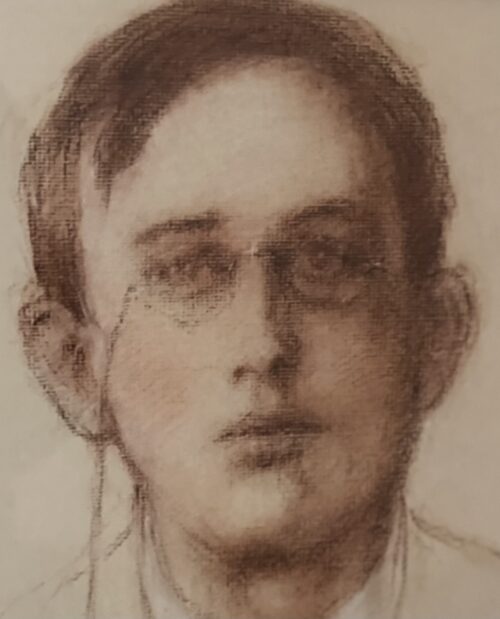
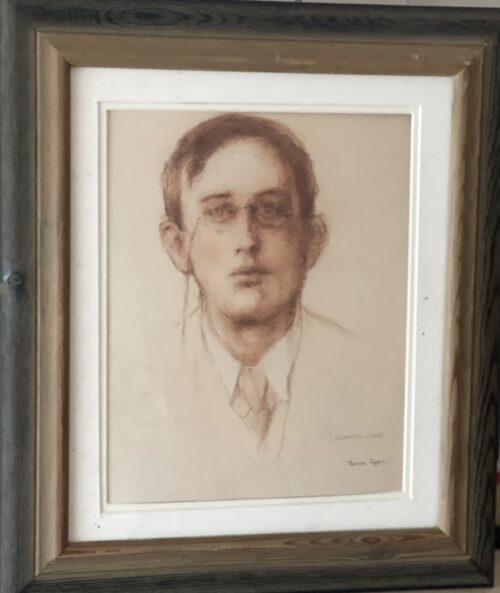 38cm x 33cm Dublin Joseph Mary Plunkett ( 21 November 1887 – 4 May 1916) was an Irish nationalist, republican, poet, journalist, revolutionary and a leader of the 1916 Easter Rising. Joseph Mary Plunkett married Grace Gifford in 1916, seven hours before his execution. The Easter Rising (Irish: Éirí Amach na Cásca), also known as the Easter Rebellion, was an armed insurrection in Ireland during Easter Week in April 1916. The Rising was launched by Irish republicans against British rule in Ireland with the aim of establishing an independent Irish Republic while the United Kingdom was fighting the First World War. It was the most significant uprising in Ireland since the rebellion of 1798 and the first armed conflict of the Irish revolutionary period. Sixteen of the Rising's leaders were executed from May 1916. The nature of the executions, and subsequent political developments, ultimately contributed to an increase in popular support for Irish independence. Organised by a seven-man Military Council of the Irish Republican Brotherhood, the Rising began on Easter Monday, 24 April 1916 and lasted for six days.Members of the Irish Volunteers, led by schoolmaster and Irish language activist Patrick Pearse, joined by the smaller Irish Citizen Army of James Connolly and 200 women of Cumann na mBan, seized strategically important buildings in Dublin and proclaimed the Irish Republic. The British Army brought in thousands of reinforcements as well as artillery and a gunboat. There was street fighting on the routes into the city centre, where the rebels slowed the British advance and inflicted many casualties. Elsewhere in Dublin, the fighting mainly consisted of sniping and long-range gun battles. The main rebel positions were gradually surrounded and bombarded with artillery. There were isolated actions in other parts of Ireland; Volunteer leader Eoin MacNeill had issued a countermand in a bid to halt the Rising, which greatly reduced the number of rebels who mobilised. With much greater numbers and heavier weapons, the British Army suppressed the Rising. Pearse agreed to an unconditional surrender on Saturday 29 April, although sporadic fighting continued briefly. After the surrender, the country remained under martial law. About 3,500 people were taken prisoner by the British and 1,800 of them were sent to internment camps or prisons in Britain. Most of the leaders of the Rising were executed following courts-martial. The Rising brought physical force republicanism back to the forefront of Irish politics, which for nearly fifty years had been dominated by constitutional nationalism. Opposition to the British reaction to the Rising contributed to changes in public opinion and the move toward independence, as shown in the December 1918 election in Ireland which was won by the Sinn Féin party, which convened the First Dáil and declared independence. Of the 485 people killed, 260 were civilians, 143 were British military and police personnel, and 82 were Irish rebels, including 16 rebels executed for their roles in the Rising. More than 2,600 people were wounded. Many of the civilians were killed or wounded by British artillery fire or were mistaken for rebels. Others were caught in the crossfire during firefights between the British and the rebels. The shelling and resulting fires left parts of central Dublin in ruins.
38cm x 33cm Dublin Joseph Mary Plunkett ( 21 November 1887 – 4 May 1916) was an Irish nationalist, republican, poet, journalist, revolutionary and a leader of the 1916 Easter Rising. Joseph Mary Plunkett married Grace Gifford in 1916, seven hours before his execution. The Easter Rising (Irish: Éirí Amach na Cásca), also known as the Easter Rebellion, was an armed insurrection in Ireland during Easter Week in April 1916. The Rising was launched by Irish republicans against British rule in Ireland with the aim of establishing an independent Irish Republic while the United Kingdom was fighting the First World War. It was the most significant uprising in Ireland since the rebellion of 1798 and the first armed conflict of the Irish revolutionary period. Sixteen of the Rising's leaders were executed from May 1916. The nature of the executions, and subsequent political developments, ultimately contributed to an increase in popular support for Irish independence. Organised by a seven-man Military Council of the Irish Republican Brotherhood, the Rising began on Easter Monday, 24 April 1916 and lasted for six days.Members of the Irish Volunteers, led by schoolmaster and Irish language activist Patrick Pearse, joined by the smaller Irish Citizen Army of James Connolly and 200 women of Cumann na mBan, seized strategically important buildings in Dublin and proclaimed the Irish Republic. The British Army brought in thousands of reinforcements as well as artillery and a gunboat. There was street fighting on the routes into the city centre, where the rebels slowed the British advance and inflicted many casualties. Elsewhere in Dublin, the fighting mainly consisted of sniping and long-range gun battles. The main rebel positions were gradually surrounded and bombarded with artillery. There were isolated actions in other parts of Ireland; Volunteer leader Eoin MacNeill had issued a countermand in a bid to halt the Rising, which greatly reduced the number of rebels who mobilised. With much greater numbers and heavier weapons, the British Army suppressed the Rising. Pearse agreed to an unconditional surrender on Saturday 29 April, although sporadic fighting continued briefly. After the surrender, the country remained under martial law. About 3,500 people were taken prisoner by the British and 1,800 of them were sent to internment camps or prisons in Britain. Most of the leaders of the Rising were executed following courts-martial. The Rising brought physical force republicanism back to the forefront of Irish politics, which for nearly fifty years had been dominated by constitutional nationalism. Opposition to the British reaction to the Rising contributed to changes in public opinion and the move toward independence, as shown in the December 1918 election in Ireland which was won by the Sinn Féin party, which convened the First Dáil and declared independence. Of the 485 people killed, 260 were civilians, 143 were British military and police personnel, and 82 were Irish rebels, including 16 rebels executed for their roles in the Rising. More than 2,600 people were wounded. Many of the civilians were killed or wounded by British artillery fire or were mistaken for rebels. Others were caught in the crossfire during firefights between the British and the rebels. The shelling and resulting fires left parts of central Dublin in ruins. -
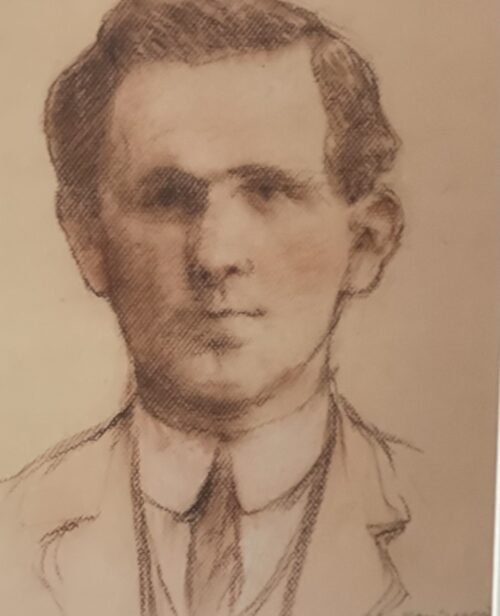
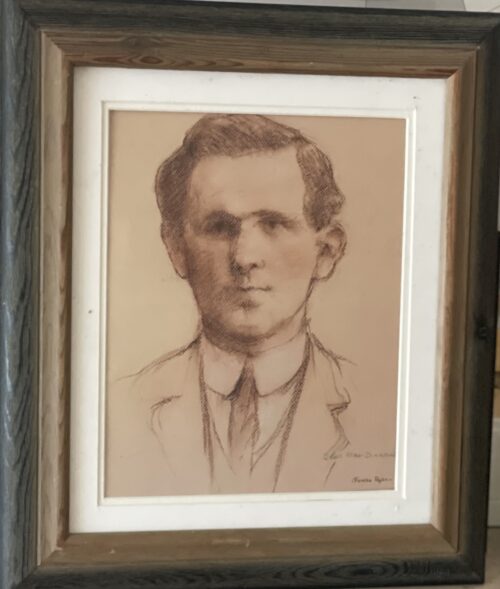 38cm x 33cm Dublin Seán Mac Diarmada (27 January 1883 – 12 May 1916), also known as Seán MacDermott, was an Irish republican political activist and revolutionary leader. He was one of the seven leaders of the Easter Rising of 1916, which he helped to organise as a member of the Military Committee of the Irish Republican Brotherhood (IRB) and was the second signatory of the Proclamation of the Irish Republic. He was executed for his part in the Rising at age 33. Brought up in rural County Leitrim, he was a member of many associations which promoted the cause of the Irish language, Gaelic revival and Irish nationalism in general, including the Gaelic League and (early in his career) the Irish Catholic fraternity the Ancient Order of Hibernians. He was national organiser for Sinn Féin, and later manager of the newspaper Irish Freedom, started in 1910 by Bulmer Hobson and others. The Easter Rising (Irish: Éirí Amach na Cásca), also known as the Easter Rebellion, was an armed insurrection in Ireland during Easter Week in April 1916. The Rising was launched by Irish republicans against British rule in Ireland with the aim of establishing an independent Irish Republic while the United Kingdom was fighting the First World War. It was the most significant uprising in Ireland since the rebellion of 1798 and the first armed conflict of the Irish revolutionary period. Sixteen of the Rising's leaders were executed from May 1916. The nature of the executions, and subsequent political developments, ultimately contributed to an increase in popular support for Irish independence. Organised by a seven-man Military Council of the Irish Republican Brotherhood, the Rising began on Easter Monday, 24 April 1916 and lasted for six days.Members of the Irish Volunteers, led by schoolmaster and Irish language activist Patrick Pearse, joined by the smaller Irish Citizen Army of James Connolly and 200 women of Cumann na mBan, seized strategically important buildings in Dublin and proclaimed the Irish Republic. The British Army brought in thousands of reinforcements as well as artillery and a gunboat. There was street fighting on the routes into the city centre, where the rebels slowed the British advance and inflicted many casualties. Elsewhere in Dublin, the fighting mainly consisted of sniping and long-range gun battles. The main rebel positions were gradually surrounded and bombarded with artillery. There were isolated actions in other parts of Ireland; Volunteer leader Eoin MacNeill had issued a countermand in a bid to halt the Rising, which greatly reduced the number of rebels who mobilised. With much greater numbers and heavier weapons, the British Army suppressed the Rising. Pearse agreed to an unconditional surrender on Saturday 29 April, although sporadic fighting continued briefly. After the surrender, the country remained under martial law. About 3,500 people were taken prisoner by the British and 1,800 of them were sent to internment camps or prisons in Britain. Most of the leaders of the Rising were executed following courts-martial. The Rising brought physical force republicanism back to the forefront of Irish politics, which for nearly fifty years had been dominated by constitutional nationalism. Opposition to the British reaction to the Rising contributed to changes in public opinion and the move toward independence, as shown in the December 1918 election in Ireland which was won by the Sinn Féin party, which convened the First Dáil and declared independence. Of the 485 people killed, 260 were civilians, 143 were British military and police personnel, and 82 were Irish rebels, including 16 rebels executed for their roles in the Rising. More than 2,600 people were wounded. Many of the civilians were killed or wounded by British artillery fire or were mistaken for rebels. Others were caught in the crossfire during firefights between the British and the rebels. The shelling and resulting fires left parts of central Dublin in ruins.
38cm x 33cm Dublin Seán Mac Diarmada (27 January 1883 – 12 May 1916), also known as Seán MacDermott, was an Irish republican political activist and revolutionary leader. He was one of the seven leaders of the Easter Rising of 1916, which he helped to organise as a member of the Military Committee of the Irish Republican Brotherhood (IRB) and was the second signatory of the Proclamation of the Irish Republic. He was executed for his part in the Rising at age 33. Brought up in rural County Leitrim, he was a member of many associations which promoted the cause of the Irish language, Gaelic revival and Irish nationalism in general, including the Gaelic League and (early in his career) the Irish Catholic fraternity the Ancient Order of Hibernians. He was national organiser for Sinn Féin, and later manager of the newspaper Irish Freedom, started in 1910 by Bulmer Hobson and others. The Easter Rising (Irish: Éirí Amach na Cásca), also known as the Easter Rebellion, was an armed insurrection in Ireland during Easter Week in April 1916. The Rising was launched by Irish republicans against British rule in Ireland with the aim of establishing an independent Irish Republic while the United Kingdom was fighting the First World War. It was the most significant uprising in Ireland since the rebellion of 1798 and the first armed conflict of the Irish revolutionary period. Sixteen of the Rising's leaders were executed from May 1916. The nature of the executions, and subsequent political developments, ultimately contributed to an increase in popular support for Irish independence. Organised by a seven-man Military Council of the Irish Republican Brotherhood, the Rising began on Easter Monday, 24 April 1916 and lasted for six days.Members of the Irish Volunteers, led by schoolmaster and Irish language activist Patrick Pearse, joined by the smaller Irish Citizen Army of James Connolly and 200 women of Cumann na mBan, seized strategically important buildings in Dublin and proclaimed the Irish Republic. The British Army brought in thousands of reinforcements as well as artillery and a gunboat. There was street fighting on the routes into the city centre, where the rebels slowed the British advance and inflicted many casualties. Elsewhere in Dublin, the fighting mainly consisted of sniping and long-range gun battles. The main rebel positions were gradually surrounded and bombarded with artillery. There were isolated actions in other parts of Ireland; Volunteer leader Eoin MacNeill had issued a countermand in a bid to halt the Rising, which greatly reduced the number of rebels who mobilised. With much greater numbers and heavier weapons, the British Army suppressed the Rising. Pearse agreed to an unconditional surrender on Saturday 29 April, although sporadic fighting continued briefly. After the surrender, the country remained under martial law. About 3,500 people were taken prisoner by the British and 1,800 of them were sent to internment camps or prisons in Britain. Most of the leaders of the Rising were executed following courts-martial. The Rising brought physical force republicanism back to the forefront of Irish politics, which for nearly fifty years had been dominated by constitutional nationalism. Opposition to the British reaction to the Rising contributed to changes in public opinion and the move toward independence, as shown in the December 1918 election in Ireland which was won by the Sinn Féin party, which convened the First Dáil and declared independence. Of the 485 people killed, 260 were civilians, 143 were British military and police personnel, and 82 were Irish rebels, including 16 rebels executed for their roles in the Rising. More than 2,600 people were wounded. Many of the civilians were killed or wounded by British artillery fire or were mistaken for rebels. Others were caught in the crossfire during firefights between the British and the rebels. The shelling and resulting fires left parts of central Dublin in ruins.



